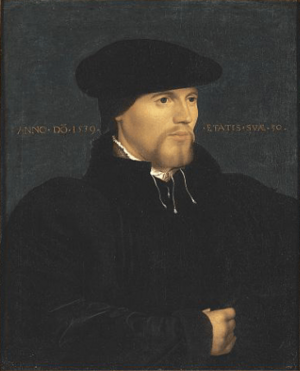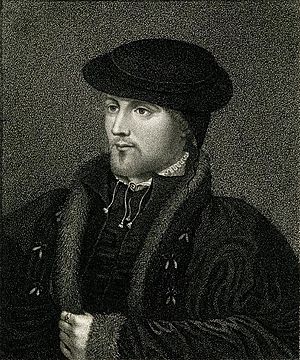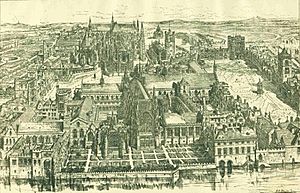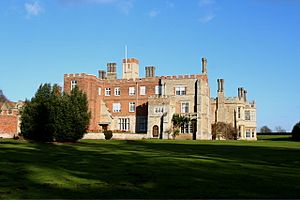Richard Williams (alias Cromwell) facts for kids
Quick facts for kids
Richard Williams
|
|
|---|---|

Portrait of a Man in Black,
perhaps Sir Richard Williams (alias Cromwell), circa 1600, follower of Hans Holbein |
|
| Member of Parliament for Huntingdonshire |
|
| In office 1539–1540 |
|
| In office 1542–1544 |
|
| Personal details | |
| Born | c. 1510 Llanishen, Glamorganshire, Wales |
| Died | 20 October 1544 (aged 33–34) |
| Spouse | Frances Murfyn |
| Children |
|
| Parents |
|
Sir Richard Williams (born around 1510 – died 20 October 1544), also known as Sir Richard Cromwell, was a Welsh soldier and courtier. He lived during the time of King Henry VIII, who made him a knight on May 2, 1540. Sir Richard was the nephew of Thomas Cromwell, a very powerful minister to King Henry VIII. He gained a lot of wealth and land during the Dissolution of the Monasteries, a time when the King closed down many religious houses. Sir Richard was also the great-grandfather of Oliver Cromwell, a famous leader in English history. He sometimes used the name Cromwell to honor his uncle, Thomas Cromwell.
Contents
Early Life and Family
Richard Williams was born around 1510 in a place called Llanishen in Glamorganshire, Wales. He was the oldest son of Morgan Williams. His father, Morgan, was a Welsh lawyer who moved to Putney, England. There, he ran an inn and a brewery.
Morgan Williams married Katherine, who was the sister of Thomas Cromwell. This marriage was very important for Richard's future. Later, both Morgan and Richard received a lot of land and money from this family connection. These lands were often taken from churches during the time of King Henry VIII.
Working with Thomas Cromwell
Richard joined the court of King Henry VIII thanks to his uncle, Thomas Cromwell. Thomas Cromwell was a very important person to the King. He rose from a simple background to become the Earl of Essex and the King's main advisor.
When Thomas Cromwell wrote his will in 1529, Richard was working for the Marquess of Dorset. By the autumn of 1529, Richard started using the name Cromwell. After the Marquess died in 1530, Richard worked for Stephen Gardiner. In 1533, he joined his uncle's household and was introduced to the King's court.
For the next ten years, Richard Cromwell (also known as Williams) was a trusted helper for his uncle. He often shared jobs and land grants with him. Because of his powerful uncle, and his own skills, Richard quickly gained favor with King Henry VIII. He was given important roles early on. He also helped to stop a rebellion called the Pilgrimage of Grace.
The Dissolution of the Monasteries
During the Dissolution of the Monasteries, Sir Richard was chosen as one of the "Visitors." These visitors were sent to inspect and close down religious houses. He was very dedicated to the King and his uncle's goals. Because of this, he was greatly rewarded. His uncle, Thomas Cromwell, likely wanted to help his family become powerful.
Sir Richard received many valuable properties. For example, on March 8, 1538, he was given the nunnery of Hinchingbrooke in Huntingdonshire. He also received the monastery of Sawtry-Judith that same year. In 1539, he got land that belonged to a dissolved church in Eynesbury. He also received the Abbey of the Grey-Friars in Great Yarmouth.
On March 4, 1540, he received the site of the very rich Abbey of Ramsey in Huntingdonshire. This was a huge property. He paid a large sum for it, but it was still much less than its true worth. These gifts showed how much the King and Thomas Cromwell valued him. All these grants were given to him under the name Richard Williams, also known as Cromwell.
Member of Parliament and High Sheriff
By 1539, Sir Richard was a gentleman of the privy chamber, which meant he was a close attendant to the King. In the same year, he was elected as a MP for Huntingdonshire.
In 1539 or early 1540, when he was about 30 years old, he might have been the subject of a portrait by the famous artist Hans Holbein the Younger.
He became a knight on May 2, 1540, during a special event called a tournament at Westminster. He showed great skill and bravery in the military games.


During the tournament, Sir Richard Cromwell performed very well. He even knocked another knight, M. Palmer, off his horse. The King was so impressed by his bravery that he reportedly said, "Formerly thou wast my Dick, but hereafter thou shalt be my diamond." The King then gave him a diamond ring. He told Sir Richard to use a diamond in his family's crest as a symbol of his bravery.
Even after his uncle, Thomas Cromwell, was executed in July 1540, Sir Richard's position and wealth were not affected. He was appointed High Sheriff of Cambridgeshire and Huntingdonshire in 1541. He was also elected as an MP for Huntingdonshire again in 1542. That same year, King Henry VIII gave him the monastery of St Mary's in Huntingdon and St Neots Priory.
Sir Richard also received other important positions and properties. These included the role of steward of the lordship of Archenfield and the constableship of Goodrich Castle. He also received the priory of St Helen Bishopsgate in London, and the castles and lands of Manorbier and Penally in Wales. He also acquired Neath Abbey in Glamorgan, which was close to his birthplace.
War in France
When war started with France in 1542, Sir Richard was sent there as a general of the infantry (foot soldiers). He led 6,000 men to join the army of Emperor Charles V. They tried to take back a town called Landrecies from the French.
The French King, Francis I of France, came to defend the town. Both sides prepared for a battle, but the French King managed to resupply the town and then leave. The allies, including the English, then attacked the French rearguard. However, they fell into a trap, and many English soldiers were captured.
Sir Richard likely showed his usual good conduct during this short war. In 1544, King Henry appointed him constable of Berkeley Castle.
Marriage and Children
By March 8, 1534, Richard had married Frances Murfyn. She was the daughter of Thomas Murfyn, a former Lord Mayor of London. Frances's stepfather, Sir Thomas Denys, was a friend of Thomas Cromwell.
Sir Richard and Frances had two sons:
- Henry Williams, alias Cromwell (1537–1604): He was Richard's oldest son and heir. Henry was the grandfather of Oliver Cromwell.
- Francis Williams, alias Cromwell (around 1541–1598): He was a Knight of the Shire for Huntingdonshire in 1572. He also served as Sheriff of Cambridgeshire and Huntingdonshire.
Death
Sir Richard's wife, Frances, died before he made his will. He wrote his will on June 20, 1544. He died on October 20, 1544. In his will, he called himself Sir Richard Williams, also known as Sir Richard Cromwell. He was also a member of the King's privy chamber.
He asked to be buried wherever he died. He left his lands in Cambridge, Huntingdon, Lincoln, and Bedford to his oldest son, Henry. He also gave Henry money for furniture when he became an adult. His lands in Glamorganshire went to his son, Francis. He also left money to his nieces and gifts to the King and other relatives and servants. His will was officially approved on November 24, 1546.
Sir Richard left a huge fortune to his family. This wealth came from lands he inherited, lands he received as gifts from the King, and lands he bought from the church. He also earned a lot from his important jobs and gifts from King Henry VIII. His estates in Huntingdonshire alone were worth a great deal of money. He also owned significant property in several other counties.



